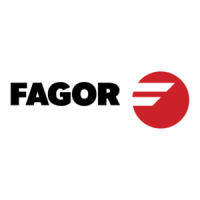Programming manual.
CNC 8070
1.
CREATING A PROGRAM.
Program block structure.
·38·
(REF: 1709)
1.3.2 High-level language programming.
The commands of high level language are made up of control instructions "#" and flow control
instructions "$".
Block structure.
A block may have the following commands, but needs not contain all of them.
·/· Block skip condition.
If the block-skip mark is active, the CNC will skip the blocks having this character (not
executing them) and will go on to the next block.
The CNC reads several blocks ahead of the one in execution, in order to calculate in advance
the path to travel. The block-skip condition is examined at the time when the block is read.
·N· Block identification.
The block identification must be programmed when the block is used as the destination of
references or jumps. In this case, it is recommended to program it alone in the block. It may
be represented in two ways:
• The letter "N" followed by the block number (0-4294967295) and the ":" character (only
when the label is used as the destination of a block jump); they need not follow a particular
order or be consecutive.
If the label is not a jump target and is programmed without ":", it may go in any position
of the block, not necessarily at the beginning.
• "[<name>]" type labels, where <name> may be up to 14 characters long and may consist
of uppercase and lowercase characters as well as numbers (no blank spaces are
allowed).
Both types of data may be programmed in the same block.
·# $· High-level language commands.
The high-level commands comprise the instructions and flow control instructions.
• Instructions are programmed preceded by the "#" sign and they can only be programmed
one per block. They are used to carry out various functions.
• Flow control instructions are programmed preceded by the "$" sign and can only be
programmed one per block. They are used to make loops and program jumps.
Assigning values to parameters and variables can also be considered as high-level
commands.
Block comment .
Any comment may be associated with the blocks. When executing the program, the CNC
ignores this information.
The CNC offers various methods to include comments in the program. See "1.8 Comment
programming." on page 47.
/ N— <rest of commands>

